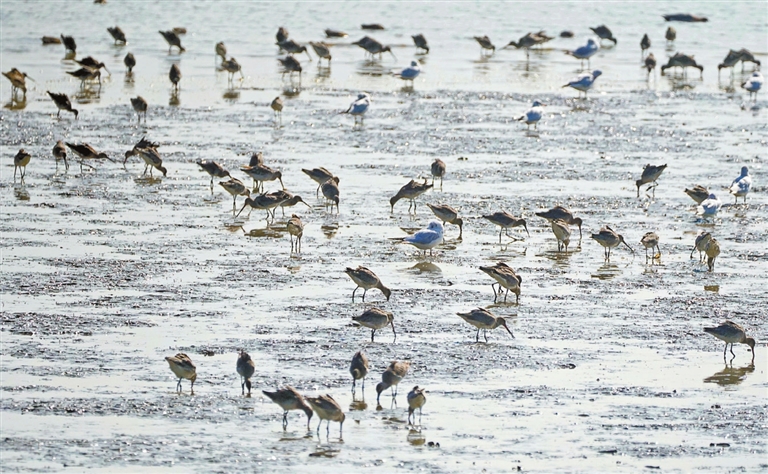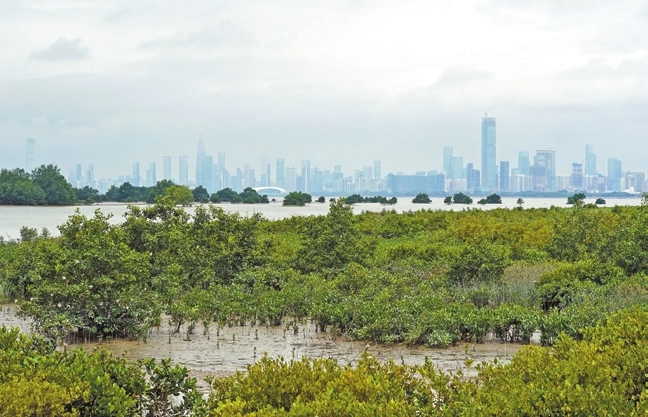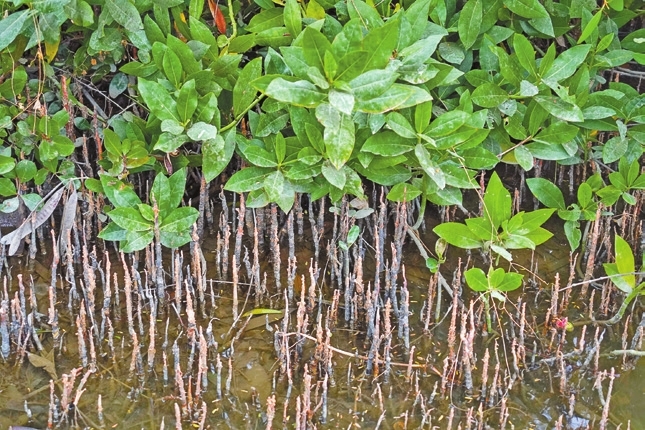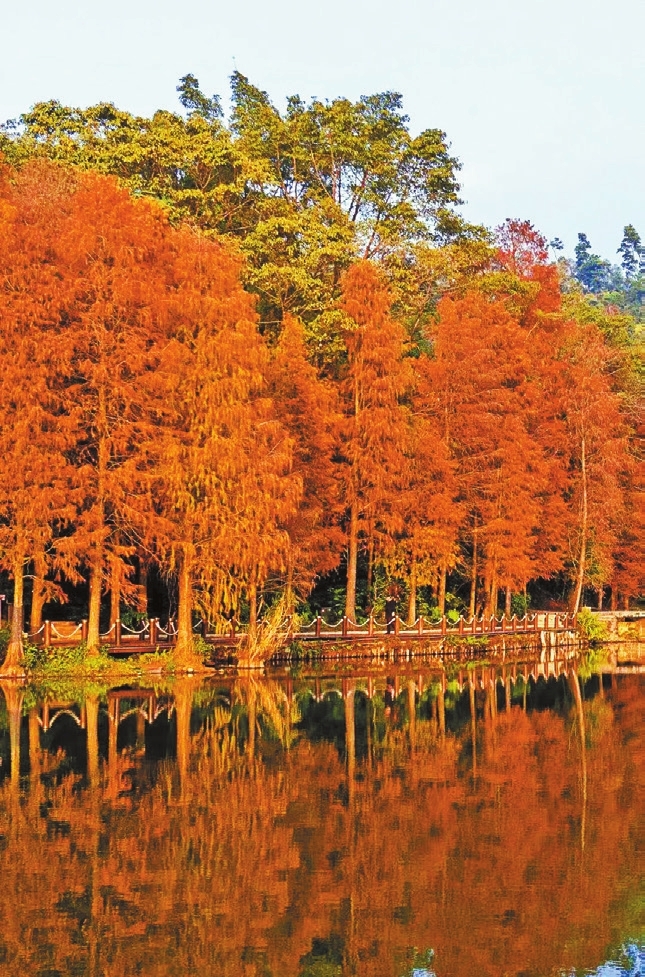



President Xi Jinping recently announced that China will build an international mangrove center in Shenzhen. Wetlands play an important role in ecological systems and in recent years Shenzhen has been stepping up wetland protection. This weekend, let’s explore some local parks with picturesque wetlands. Futian District Futian Mangrove Ecological Park 福田红树林生态公园 Located in the northeast estuary of Shenzhen Bay, Futian Mangrove Ecological Park is in the east side of the Futian Mangrove Nature Reserve, the only nature reserve in an urban area in China. Opposite the park is Hong Kong Mai Po Nature Reserve, which also constitutes part of the Shenzhen Bay wetland ecosystem. Shenzhen is an important stopover for migratory birds’ journeys along the East Asia-Australia Flyway. There are more than 100 species of birds and about 100,000 migratory birds flying here to spend the winter. The nature reserve, a paradise for birds and home to a wide range of plants, has been acclaimed for many years as one of the 10 most beautiful wetlands in Guangdong. On Nov. 9, Futian Mangrove Ecological Park snatched Star Wetland Center Award. Metro: Line 7 to Shawei Station (沙尾站), Exit B, and walk southward for 1.1 km Shenzhen Central Park 深圳中心公园 Covering 147 hectares, Shenzhen Central Park is in the heart of Futian District. With lots of greenery, lakes and Futian River, the park is spacious and peaceful, and has multiple entrance gates. Metro: Line 3 or 7 to Huaxin Station (华新站), Exit D Nanshan District OCT National Wetland Park 华侨城国家湿地公园 The OCT National Wetland Park’s 50,000-square-meter mangrove wetland is an important habitat for birds. An exhibition hall, bird-watching spots and a school in the park help the public know more about wetland natural resources. The park also snatched Star Wetland Center Award this week. Booking: WeChat account “OCT_Wetland” Metro: Line 9 to Shenwan Station (深湾站), Exit C Shenzhen Bay Park 深圳湾公园 The Futian Mangrove Nature Reserve connects Shenzhen Bay Park in the west, which forms a pretty large area. Along the meandering mangroves, visitors can have spectacular views of migratory birds gathering here from September to May every year. The Mangrove Coastal Ecological Park and the Sunrise Theater areas in the massive Shenzhen Bay Park are popular places to observe birds. Metro: Line 9 to Shenzhen Bay Park Station (深圳湾公园站), Exit D2 Jiuxiangling Wetland Park 九祥岭湿地公园 As part of the Dasha River Ecological Corridor, Jiuxiangling Wetland Park is located north of Liuxian Boulevard and west of Dasha River. The park has a lake and greenway, providing residents a spot for relaxation. Metro: Line 5 or 7 to Xili Station (西丽站), Exit D Luohu District Honghu Park 洪湖公园 With three lakes inside, Honghu Park is almost entirely covered by water and is famous for abundant lotus flowers in summer and russet-red bald cypresses in winter. Metro: Line 7 to Honghu Station (洪湖站), Exit A Donghu Park 东湖公园 Donghu Park connects Wutong Mountain in the east and Shenzhen Reservoir to the north. The lakes in the park are surrounded by lush and verdant aquatic plants. Metro: Line 5 or 7 to Tai’an Station (太安站), Exit C and then walk eastward for 1.1 km Bao’an District Xiwan Mangrove Park 西湾红树林公园 Acclaimed as one of the best places to view sunsets in Shenzhen, Xiwan Mangrove Park is a coastal spot with several viewing platforms, vast greenery and mangroves. Metro: Line 1 to Gushu Station (固戍站), Exit D and then walk eastward for 1.5 km Haoxiang Lake Park 蚝乡湖公园 Haoxiang Lake Park is connected to four urban rivers: Pailao River, Xinqiao River, Wanfeng River and Tantou River. It plays an important role in flood control and pollution interception. Through urban renewal, the space surrounding the lake has been transformed into a waterfront park with a pedestrian loop connecting the four riverside spaces. The park was shortlisted in the landscape project category of Dezeen Awards 2021. Metro: Line 11 to Houting Station (后亭站), Exit B Shiyan Wetland Park 石岩湿地公园 The vast Shiyan Lake is surrounded by Shiyan Wetland Park, Shiyan Reservoir, Qingcaopai Park (青草排公园) and Moshanghua Park (陌上花公园). Running on the 30.5-km Shiyan Lake Greenway, one can enjoy the tranquil and soothing environment around the lake. Metro: Line 6 to Shangwu Station (上屋站), Exit B and then take a taxi Yanluo Wetland Park 燕罗湿地公园 Yanluo Wetland Park on the south bank of Maozhou River used to be a stinky shoal. Through ecological management, the wetland has greatly improved the overall water quality. With reed marshes and lush greenery, the park is a popular relaxing spot. Metro: Line 6 to Songgang Park Station (松岗公园站), Exit D and then take a taxi Yantian District Enshang Wetland Park 恩上湿地公园 In Enshang Wetland Park on Wutong Mountain, you can enjoy an ocean of various flowers, well-preserved trees and the Enshang Reservoir. You can get an amazing view of the mountain and the sea in Yantian. Metro: Line 8 to Haishan Station (海山站), Exit C and then walk northward and climb Wutong Mountain Longhua District Guanlan River Wetland Park 观澜河湿地公园 Located on the west bank of Guanlan River, the park, with several artificial wetlands, is famous for its water canna, a wetland plant with firecracker-shaped red blooms. Standing on a viewing platform, one can enjoy the river scenery that includes frequent visits by egrets. Metro: Line 4 to Zhucun Station (竹村站), Exit D Pingshan District Pingshan Wetland Park 坪山湿地公园 As a component of sponge-city construction and river improvement, 10 wetlands have been built along Pingshan River in recent years. On its north bank, Pingshan Wetland Park is small but has a peaceful landscape and is host to a variety of birds. Metro: Line 14 to Shatian Station (沙田站), Exit D and then take a taxi Julongshan Ecological Park 聚龙山生态公园 The Julongshan park, 3 km north of Pingshan Wetland Park, is very spacious with massive greenery and lakes. Metro: Line 14 to Shatian Station (沙田站), Exit D and then take a taxi Longgang District Pingdi Wetland Park 坪地湿地公园 On the east bank of Longgang River, the park has vast water area with abundant plants. Metro: Line 3 to Shuanglong Station (双龙站), Exit B and then take a taxi Guangming District Loucun Wetland Park 楼村湿地公园 The park is famous for large fields of flowers such as rapeseed, sunflower and canna indica. Metro: Line 6 to Loucun Station (楼村站), Exit B Ejingshui Wetland Park 鹅颈水湿地公园 The park was built for ecological management and wetland protection. Currently there are more than 130 species of plants, offering a nice habitat for birds and insects. Metro: Line 6 to Fenghuang Town Station (凤凰城站), Exit D and then take a taxi Dapeng New Area In Dapeng, Dongchong Mangrove Wetland Park (东涌红树林湿地园), Baguang Tulip Mangrove Wetland Park (坝光银叶树湿地园) and Hetang Wetland Park (禾塘湿地公园) are perfect places for weekend vacations. The Dongchong park is famous for its exuberant excoecaria agallocha, a mangrove species; the Baguang park boasts beautiful views of tulip mangroves; and the Hetang park has a large field of hairawn muhly. It’s suggested that you drive to Dapeng. (Cao Zhen) | 
